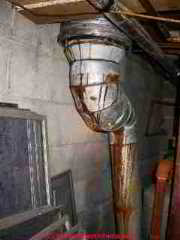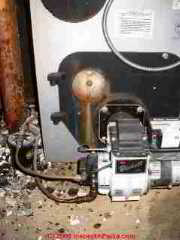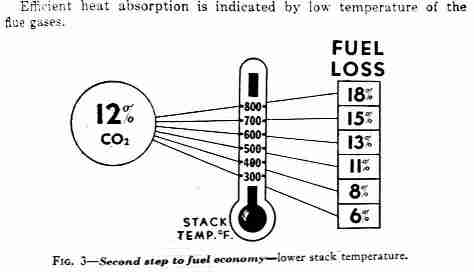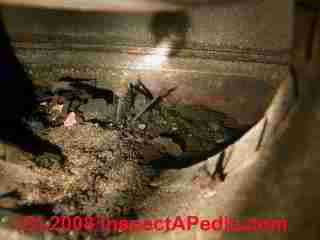 Oil Burner Problems in the Utility Room
Oil Burner Problems in the Utility Room
- POST a QUESTION or COMMENT about oil burner inspection, diagnosis, & repair, troubleshooting procedure, how to get the oil burner running again, best order of diagnostic steps.
Signs of oil burner trouble in the utility room include several problems easily observed by eye and ear.
Noticing what's going on, even something as simple as a utility room door that is shut to cut off combustion air, can make a big difference in diagnosing oil burner malfunctions.
This article series explains how to inspect, diagnose & repair oil burners used on oil-fired heating boilers or furnaces using a visual inspection approach as well as (optional) simple test equipment.
We include a description of common oil burner adjustment and operating problems and we illustrate some of the basic oil burner tests and measurements made in servicing and adjusting the equipment for safe, efficient operation. The articles at this website describe how to recognize common oil-fired heating appliance operating or safety defect.
InspectAPedia tolerates no conflicts of interest. We have no relationship with advertisers, products, or services discussed at this website.
- Daniel Friedman, Publisher/Editor/Author - See WHO ARE WE?
Boiler or Furnace Room Clues May Explain Oil Burner Trouble
 An expert inspection of an oil burner begins either with having made note of building owner/occupant concerns (noises, odors, no heat, high fuel costs), or with having made some basic visual observations outside: a sooty chimney top, for example.
An expert inspection of an oil burner begins either with having made note of building owner/occupant concerns (noises, odors, no heat, high fuel costs), or with having made some basic visual observations outside: a sooty chimney top, for example.
The page top photo shows signs of water running down the chimney and through the flue vent connector - a possible cause of damage to the heating equipment.
The chimney itself may just need a rain cap, or the chimney may actually be unsafe, having been damaged by water, spalling, rust, or frost.
In our photo of the oil burner at above/left we see lots of soot, debris and crud around the unit - and a rusty lally column.
[Click to enlarge any image]
We also see what looks like water stains below the round combustion chamber inspection port to the upper left of the oil burner.
This heating equipment needs a much closer inspection for condition and for safety; I suspect there's water damage.
The oil burner inspection continues indoors, even before entering the utility room where the oil burner (or often more than one of them if oil fuel is used for both heating and a separate water heater) is located: look at the building interior as you enter:
are there odors, soot deposits, noises associated with the heating system?
The oil burner inspection becomes detailed, and diagnostic, when you can actually see the equipment.
It's obvious that you should notice oil leaks, soot in the boiler or furnace room, noises, odors, signs of repeated repairs, piles of junked parts, signs of unprofessional work (covers off of controls, sloppy wiring or plumbing).
But just what each of these clues might mean bears some additional explanation that we offer below.
- First, Identify the heating system components in each building area.
How old is the equipment, what are the signs that parts have been replaced (new transformer, new valves, new oil piping, new filters, new fuel units, discarded parts nearby).
- Oil burner controls may themselves be a source of trouble -
See CAD CELL RELAY SWITCH
and STACK RELAY SWITCH and also
see AQUASTAT CONTROL Functions
and THERMOSTATS.
For oil fired warm air systems (furnaces) also
see FAN LIMIT SWITCH control on heating furnaces.
Controls for oil fired steam heating systems are discussed
at STEAM HEATING SYSTEMS.
- Look for damage to the furnace or boiler itself: if the boiler or furnace is old, cracked, rusted-through, leaking, damaged, repairing the oil burner may be the least of the owner's risks.
And if the boiler, furnace, or water heater is unsafe or needs immediate repair or replacement, fixing the oil burner and leaving the job is dangerous.
Our photo above shows a rusted-out furnace that should not be used, and needs immediate replacement. Fixing its oil burner, or even inspecting it would be foolish
Watch out: if it is in use, this furnace should be left shut down, red-tagged, and appropriate oral and written warnings issued.
If the furnace, boiler, or water heater has had a safety recall, that's critical information for the owners to know about.
For example,
see BLUERAY HEATING BOILERS & FURNACES SAFETY RECALLby the US CPSC, with additional history, photos, and technical details. - Look at the heating equipment's service tag: has the equipment been serviced annually; are there records of other no-heat service calls
- often a good service tech will note on the service tag the no-heat call, the diagnosis, and what parts were replaced.
At HEATING COST REDUCTION ADVICE: How to Save on Home Heating Costs, we discuss heating tuneup tips for oil burners to reduce heating cost.

- Oil fired equipment efficiency measurements: If you do not see a small (roughly 1/4" diameter) hole in the flue vent connector just above the boiler, before the barometric damper, then this heating equipment has never been properly tuned and measured for proper operation.
While it was possible to "eyeball" older oil fired equipment (spit on the flue for temperature and blow cigarette smoke at the burner for draft), modern oil fired equipment requires more accurate measurement and adjustment for good operation.
As our sketch from the AUDEL OIL BURNER GUIDE (free online book) shows, measuring the stack temperature and CO2 level gives a critical indication of the heating system efficiency, in other words, measuring what percent of each dollar spent on heating oil is going up the chimney versus into the building as heat.
The Guide also includes this CHART of OIL FIRED HEATING SYSTEM EFFICIENCY[image] at different CO2 levels and stack temperatures.
The little hole we describe is where the service tech inserts test equipment to measure stack temperature, smoke level, and CO level. Some tech's use two holes to permit more than one measurement simultaneously. No hole in the flue vent connector means that this heating system has never measured. (Or new flue vent connector parts have just been installed on older equipment and no one has made a hole yet.)
No hole in the flue vent connector means that this heating system has never measured. (Or new flue vent connector parts have just been installed on older equipment and no one has made a hole yet.)
Details about this procedure for measuring oil burner efficiency are
Our photo (left) shows a Bachrach stack temperature measurement being made "in the breech" above a troublesome oil burner and boiler installation.
Watch out: don't record the stack temperature before the oil-fired heating system has been running for five minutes or so - you want to be sure the system has reached its stable and "normal" operating temperature.
Waiting a few minutes at this boiler we saw the flue temperature rise to 600 °F [photo]
At 600 °F. this heating system was left running a bit "hot" by the service tech. Why? Because a too-short chimney meant the system had a history of inadequate draft, sooting, backpressure, puffbacks, and loss of heat. This "fix" was a band-aid that kept the system running longer between (frequent) service calls, but at the expense of higher heating bills and wasted fuel.
We could have addressed this short chimney with a draft inducer fan, but a taller flue would be smart anyway, to get the chimney top higher than the roof surface. We discuss examples of extending chimney height to improve draft, performance, and fire safety separately
at CHIMNEY HEIGHT EXTENSIONS. We discuss draft inducer or "draft boosting" fans for heating systems (and maybe for some fireplaces)
in detail at DRAFT INDUCER FANS.
Just how short is "too short" for a chimney is a problem along with roof clearance requirements discussed
- At the heating boiler or furnace, identify the fuel source and follow fuel supply piping to its source (an oil tank, LP gas tank, or gas meter, for example) - you may spot the oil leaks and piping problems we mentioned above.
- Look at the oil burner combustion air supply - it's remarkable how often the oil burner service tech tunes up the system with the door to the boiler or furnace room open (who wants to work in a little closet), then leaves, closing the door, and shutting off the only combustion air supply to the equipment - a likely cause of sooty operation and other troubles.
See COMBUSTION AIR DEFECTS.
- Look at the furnace or boiler connection to the chimney - the flue vent connector, barometric damper, and for signs of trouble with the chimney itself (no cleanout door, air leaks, blocked flue).
See CHIMNEY INSPECTION DIAGNOSIS REPAIR for the chimney itself, and
see FLUE VENT CONNECTORS, HEATING EQUIPMENT for a discussion of flue vent connectors, signs of blocked flues, dead end chimney hazards, and other venting defects that can cause oil burner operating problems. - Look at and look into the barometric damper or draft regulator: is there one installed, is it properly installed, is the flue thick with soot, is soot blowing out of the draft regulator?
Our photo, left, shows so much debris in the breech of this oil fired heater that the oil burner is likely to see trouble itself.
See DRAFT REGULATOR, DAMPER, BOOSTER for details.
A discussion of this particular photo and those rusty sooty fragments in view is found
at HOW TO INSPECT a BAROMETRIC DAMPER or draft regulator
Readers needing an approach to heating system inspections that assures thoroughness, should also
see HEATING SYSTEM INSPECTION PROCEDURE where we explain an organized approach to inspecting the entire heating system, beginning outdoors, continuing indoors, and ultimately in most detail in the boiler or furnace room.
To find what you need quickly, if you don't want to scroll through this index you are welcome to use the page top or bottom SEARCH BOX to search InspectApedia for specific articles and information.
...
Continue reading at OIL BURNER VISUAL INSPECTION or select a topic from the closely-related articles below, or see the complete ARTICLE INDEX.
Or see these
Recommended Articles
- OIL BURNER INSPECTION & REPAIR
- BUILDING EXTERIOR Oil Burner Trouble
- BUILDING INTERIOR Oil Burner Trouble
- OIL TANK EFFECTS on OIL BURNER
- BOILER / FURNACE ROOM TROUBLE SIGNS
- OIL BURNER VISUAL INSPECTION
- OIL BURNER OPERATING TROUBLE
- OIL BURNER INSIDE TROUBLE
- OIL BURNER CO2 TEST
- OIL BURNER SMOKE TEST
- OIL BURNER WONT RUN - Diagnostic Steps - what to check in what order
- HEAT WON'T TURN ON
Suggested citation for this web page
BOILER / FURNACE ROOM TROUBLE SIGNS at InspectApedia.com - online encyclopedia of building & environmental inspection, testing, diagnosis, repair, & problem prevention advice.
Or see this
INDEX to RELATED ARTICLES: ARTICLE INDEX to HEATING OIL, OIL BURNERS, OIL FIRED HEATERS, OIL TANKS
Or use the SEARCH BOX found below to Ask a Question or Search InspectApedia
Ask a Question or Search InspectApedia
Try the search box just below, or if you prefer, post a question or comment in the Comments box below and we will respond promptly.
Search the InspectApedia website
Note: appearance of your Comment below may be delayed: if your comment contains an image, photograph, web link, or text that looks to the software as if it might be a web link, your posting will appear after it has been approved by a moderator. Apologies for the delay.
Only one image can be added per comment but you can post as many comments, and therefore images, as you like.
You will not receive a notification when a response to your question has been posted.
Please bookmark this page to make it easy for you to check back for our response.
IF above you see "Comment Form is loading comments..." then COMMENT BOX - countable.ca / bawkbox.com IS NOT WORKING.
In any case you are welcome to send an email directly to us at InspectApedia.com at editor@inspectApedia.com
We'll reply to you directly. Please help us help you by noting, in your email, the URL of the InspectApedia page where you wanted to comment.
Citations & References
In addition to any citations in the article above, a full list is available on request.
- Anthony Alaggio can be contacted through Bottini Fuel (Hudson Valley, NY) or directly for HVAC service at 914-489-0632. Email: crackin95vtec@yahoo.com Special thanks to Mr. Alaggio, an HVAC service technician for technical suggestions regarding oil heat troubleshooting & more causes of oil burner short-cycling 4/12/2013.
- [2] Beckett Corporation, 38251 Center Ridge Rd., North Ridgeville, OH 44039 440-327-1060 Email: sales@beckettcorp.com supplies residential and commercial oil burners for boilers, furnaces, and water heaters - see www.beckettcorp.com/
- [3] Audels Oil Burner Guide, Installation, Servicing, Repairing, Frank D. Graham, 1947 edition (obsolete, out of print). See Brumbaugh, James E. Audel HVAC Fundamentals, Volume 2: Heating or see various versions of this guide available in editions from 1947, 1950, 1955, 1958, 1959, 1962, 1965, 1967, and at prices from around $3.00 to nearly $70.00 - useful for simple, clear, but not current, explanation of how heating equipment works. The original retail price was $1.00. Used copies are available
- [3a] Brumbaugh, James E., Audel HVAC Fundamentals, Volume 2: Heating, Audel [J Wiley]; All New 4th Edition edition (July 2, 2004) ISBN-10: 0764542079 ISBN-13: 978-0764542077
- [4] A Total Look at Oil Burner Nozzles, available from Delavan Fuel Metering Products, a reference guide for oil burner service technicians, Delavan Spray Technologies, Fuel Metering Products Division, PO Box 969, Bamberg SC 29003, Tel: 800-982-6943 or 803-245-4347, ( Delavan is a division of BF Goodrich); web search 12/30/2010, original source: http://www.delavaninc.com/pdf/total_look.pdf
Note & disclosure: when we (DF) were servicing oil burner equipment, Delavan nozzles gave us such excellent results, especially using hollow cone spray patterns in solving combustion problems, that this brand was our standard stock-item on our truck. Other brands of oil burner nozzles are of course also of excellent quality. It is the proper matching of nozzle size and type and spray pattern to the equipment that is critical. - [5] Fuel Nozzles for Oil Burners, Technical Aspects of Applications, E. O. Olson, Chief Engineer (deceased)
Delavan Fuel Metering Products Operation, Bamberg, South Carolina, Delavan Fuel Metering Products, a reference guide for oil burner service technicians, Delavan Spray Technologies, Fuel Metering Products Division, PO Box 969, Bamberg SC 29003, Tel: 800-982-6943 or 803-245-4347, ( Delavan is a division of BF Goodrich); web search 12/30/2010, original source: http://www.delavaninc.com/pdf/Fuel_Nozzles_for_Burners.PDF - [6] Domestic and Commercial Oil Burners, Charles H. Burkhardt, McGraw Hill Book Company, New York 3rd Ed 1969.
- National Fuel Gas Code (Z223.1) $16.00 and National Fuel Gas Code Handbook (Z223.2) $47.00 American Gas Association (A.G.A.), 1515 Wilson Boulevard, Arlington, VA 22209 also available from National Fire Protection Association, Batterymarch Park, Quincy, MA 02269. Fundamentals of Gas Appliance Venting and Ventilation, 1985, American Gas Association Laboratories, Engineering Services Department. American Gas Association, 1515 Wilson Boulevard, Arlington, VA 22209. Catalog #XHO585. Reprinted 1989.
- [7] The Steam Book, 1984, Training and Education Department, Fluid Handling Division, ITT [probably out of print, possibly available from several home inspection supply companies] Fuel Oil and Oil Heat Magazine, October 1990, offers an update,
- [12] "Residential Steam Heating Systems", Instructional Technologies Institute, Inc., 145 "D" Grassy Plain St., Bethel, CT 06801 800/227-1663 [home inspection training material] 1987
- [13] "Residential Hydronic (circulating hot water) Heating Systems", Instructional Technologies Institute, Inc., 145 "D" Grassy Plain St., Bethel, CT 06801 800/227-1663 [home inspection training material] 1987
- [14] "Warm Air Heating Systems". Instructional Technologies Institute, Inc., 145 "D" Grassy Plain St., Bethel, CT 06801 800/227-1663 [home inspection training material] 1987
- [15] Heating, Ventilating, and Air Conditioning Volume I, Heating Fundamentals,
- [16] Boilers, Boiler Conversions, James E. Brumbaugh, ISBN 0-672-23389-4 (v. 1) Volume II, Oil, Gas, and Coal Burners, Controls, Ducts, Piping, Valves, James E. Brumbaugh, ISBN 0-672-23390-7 (v. 2) Volume III, Radiant Heating, Water Heaters, Ventilation, Air Conditioning, Heat Pumps, Air Cleaners, James E. Brumbaugh, ISBN 0-672-23383-5 (v. 3) or ISBN 0-672-23380-0 (set) Special Sales Director, Macmillan Publishing Co., 866 Third Ave., New York, NY 10022. Macmillan Publishing Co., NY
- [17] Installation Guide for Residential Hydronic Heating Systems
- [18] Installation Guide #200, The Hydronics Institute, 35 Russo Place, Berkeley Heights, NJ 07922
- The ABC's of Retention Head Oil Burners, National Association of Oil Heat Service Managers, TM 115, National Old Timers' Association of the Energy Industry, PO Box 168, Mineola, NY 11501. (Excellent tips on spotting problems on oil-fired heating equipment. Booklet.)
- [19] Crown Serviceman's Handbook: Ignition Electrode Assemblies, Terminals and Cable, Tools and Accessories, Crown Engineering Corporation, Marlboro, NJ 07746 [1986]. This publication includes oil burner troubleshooting diagnostic suggestions reprinted with permission of Fuel Oil & Oil Heat Magazine.
- [21] The Wholesaler's & Installer's Guide to OEM Oil Specifications, R.W. Beckett Corporation, PO Box 1289, Elyria, OH 44036, 216-327-1060 [1988] This publication gives the model, burner type, air tube combination, head type, static plat dimensions, blower wheel dimensions, and oil burner nozzle type for just about ever manufacturer and model of oil fired heating equipment including Addison Products, Axeman-Anderson, Bard Manufacturing, BDP, Borg-Warner, Boyertown Furnace, Burnham, Carrier Corp., Clare Brothers, Columbia Boiler Co., Crown Industries, Dornback Furnace, Ducane, Dunkirk Radiator, Duo-Matic/Olsen, Electric Furnace-Man, Ener Royal Technology, Energy Kinetics, Everhot All-Corporation, F.P. Industry, Fraser-Johnston, Heat Controller, Hydrotherm Inc., Johnson Corp., Lochinvar, Logwood-Marathon Heater, Inc., Longwood Furnace Corp., Luxaire, Magic Chef, Melvin Manufacturing Corp., Metromatic Mfg. Co., Miller Heating & A/C, Modine Manufacturing, Newmac Manufacturing, New Yorker, Oneida Heater, Peerless Heater, Perfection Products, Pow-R-Matic, Inc., Reznor, Rheem Manufacturing, Ruud, Slant/Fin, H.B. Smith, State Industries, Tekton Corp., Teledyne Laars, Thermo Dynamics, Thermo Products, Trianco, Inc., Ultimate Eng., Utica Boiler, Vallant, Van Wert Manufacturing, Weil-Mclain, Williamson Co., Wise, Inc., XXth Century. But believe it or not this is not the whole list of manufacturers from the 1970's and 1980's. Reference [22] below includes a still longer list.
- [22] Steinen's [Oil Burner] Nozzle Guide, Oil burner nozzle specifications, draft regulators, nozzle filters, flame mirrors, oil burner nozzle kits, nozzle racks, nozzle extractors, nozzle adapters. Wm. Steinen Mfg. Co., 29 East Halsey Rd., Parsippany NJ 07054, Tel: 201-887-6400 [1970].
- [22] Burnham Heating Helper, [heating system design & layout in a mini booklet], Burnham Corporation, PO Box 3089, Lancaster PA 17603, Tel: 717-481-8400, 9th printing, 7/01
- Our recommended books about building & mechanical systems design, inspection, problem diagnosis, and repair, and about indoor environment and IAQ testing, diagnosis, and cleanup are at the InspectAPedia Bookstore. Also see our Book Reviews - InspectAPedia.
- Audels Oil Burner Guide, Installation, Servicing, Repairing, Frank D. Graham, 1940's edition (obsolete). Updated versions of this guide are available in various editions, 1947, 1950, 1955, 1958, 1959, 1962, 1965, 1967, and at prices from around $3.00 to nearly $70.00 - useful for simple, clear, but not current, explanation of how heating equipment works. The original retail price was $1.00. Used copies are available
- Domestic and Commercial Oil Burners, Charles H. Burkhardt, McGraw Hill Book Company, New York 3rd Ed 1969.
- National Fuel Gas Code (Z223.1) $16.00 and National Fuel Gas Code Handbook (Z223.2) $47.00 American Gas Association (A.G.A.), 1515 Wilson Boulevard, Arlington, VA 22209 also available from National Fire Protection Association, Batterymarch Park, Quincy, MA 02269. Fundamentals of Gas Appliance Venting and Ventilation, 1985, American Gas Association Laboratories, Engineering Services Department. American Gas Association, 1515 Wilson Boulevard, Arlington, VA 22209. Catalog #XHO585. Reprinted 1989.
- The Steam Book, 1984, Training and Education Department, Fluid Handling Division, ITT [probably out of print, possibly available from several home inspection supply companies] Fuel Oil and Oil Heat Magazine, October 1990, offers an update,
- Principles of Steam Heating, $13.25 includes postage. Fuel oil & Oil Heat Magazine, 389 Passaic Ave., Fairfield, NJ 07004.
- The Lost Art of Steam Heating, John Doe [Dan Holohan], 516-579-3046 FAX, at Amazon.com>
- Principles of Steam Heating, Dan Holohan, technical editor of Fuel Oil and Oil Heat magazine, 389 Passaic Ave., Fairfield, NJ 07004 ($12.+1.25 postage/handling).
- Principles of Home Inspection: Steam, Electric & Wall/Floor Heating, Carson Dunlop Associates, at Amazon.com>
- "Residential Steam Heating Systems", Instructional Technologies Institute, Inc., 145 "D" Grassy Plain St., Bethel, CT 06801 800/227-1663 [home inspection training material] 1987
- Boilers, Boiler Conversions, James E. Brumbaugh, ISBN 0-672-23389-4 (v. 1) Volume II, Oil, Gas, and Coal Burners, Controls, Ducts, Piping, Valves, James E. Brumbaugh, ISBN 0-672-23390-7 (v. 2) Volume III, Radiant Heating, Water Heaters, Ventilation, Air Conditioning, Heat Pumps, Air Cleaners, James E. Brumbaugh, ISBN 0-672-23383-5 (v. 3) or ISBN 0-672-23380-0 (set) Special Sales Director, Macmillan Publishing Co., 866 Third Ave., New York, NY 10022. Macmillan Publishing Co., NY
- Installation Guide for Residential Hydronic Heating Systems
- Installation Guide #200, The Hydronics Institute, 35 Russo Place, Berkeley Heights, NJ 07922
- The ABC's of Retention Head Oil Burners, National Association of Oil Heat Service Managers, TM 115, National Old Timers' Association of the Energy Industry, PO Box 168, Mineola, NY 11501. (Excellent tips on spotting problems on oil-fired heating equipment. Booklet.)
- In addition to citations & references found in this article, see the research citations given at the end of the related articles found at our suggested
CONTINUE READING or RECOMMENDED ARTICLES.
- Carson, Dunlop & Associates Ltd., 120 Carlton Street Suite 407, Toronto ON M5A 4K2. Tel: (416) 964-9415 1-800-268-7070 Email: info@carsondunlop.com. Alan Carson is a past president of ASHI, the American Society of Home Inspectors.
Thanks to Alan Carson and Bob Dunlop, for permission for InspectAPedia to use text excerpts from The HOME REFERENCE BOOK - the Encyclopedia of Homes and to use illustrations from The ILLUSTRATED HOME .
Carson Dunlop Associates provides extensive home inspection education and report writing material. In gratitude we provide links to tsome Carson Dunlop Associates products and services.



